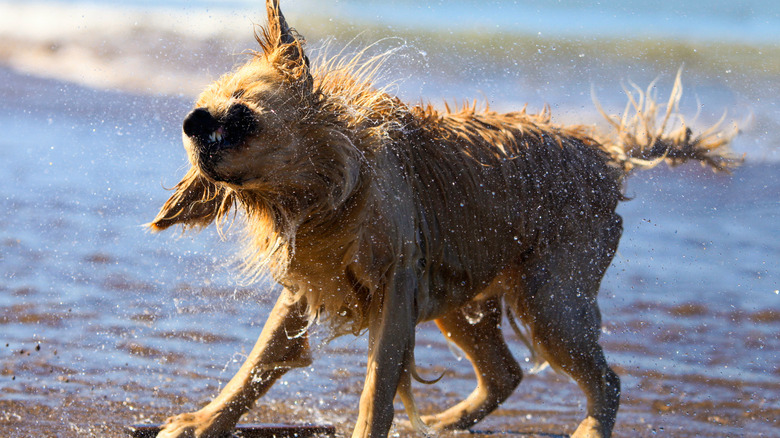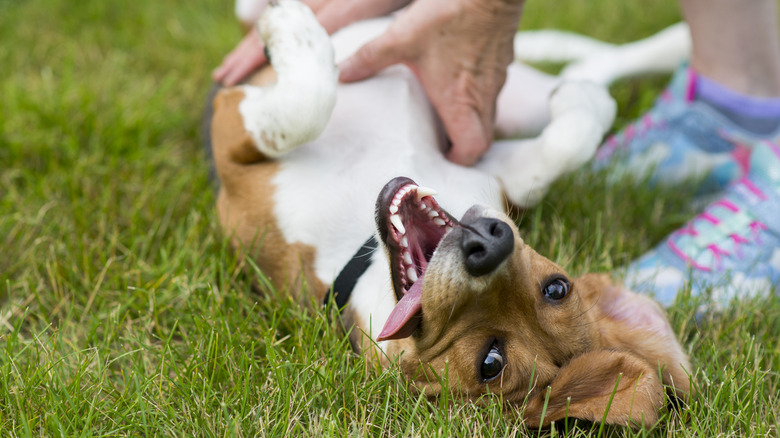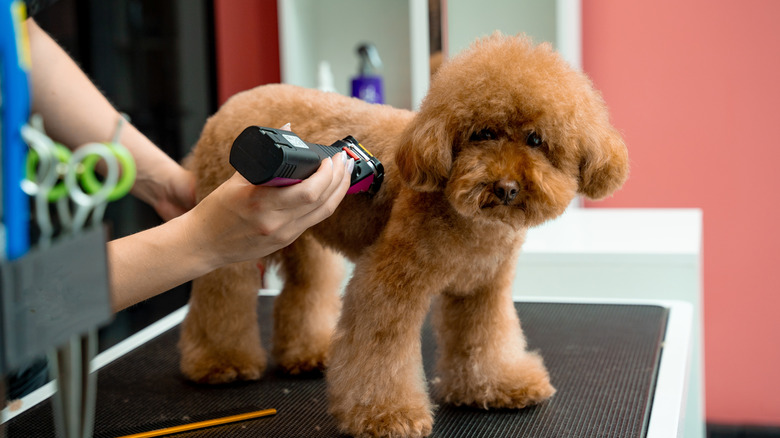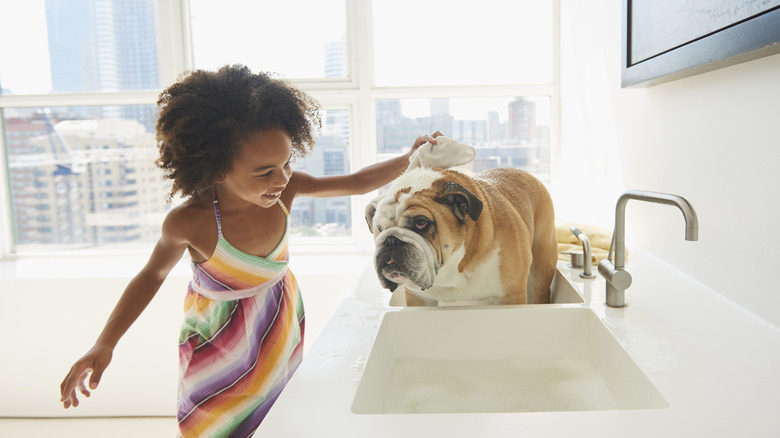How To Groom Your Dog For Summer (And The Biggest Mistakes To Avoid)
We may receive a commission on purchases made from links.
Summertime has unique challenges for pet owners, such as monitoring a dog's temperature against their excitement of adventuring on sunny days, seasonal outdoor pests looking to latch on, and messes from rolling around in the ground. Thankfully, many of these concerns can be dealt with through proper grooming, from ensuring your dog's coat is ready for the season to knowing how and where to check for any debris or insects that like to attach themselves to a dog.
At the same time, the grooming process is not always straightforward, with different breeds having different challenges getting them summer-ready. A furry friend's unique personality is part of their charm, but sometimes they can be stubborn about being on the same page as you when implementing a regular grooming routine. Still, following the dos and don'ts of summertime grooming and considering your pet's needs can make for a fun and (mostly) mess-free summer.
Keep ears clean and dry
Some dogs love going for a cool dip in the summer, and popular breeds like the Newfoundland and golden retriever are particularly adept at swimming. While swimming is an excellent way for dogs to exercise and can benefit older dogs with joint issues, it poses risks to canines. Water allows bacteria or yeast to build up in the ears, possibly leading to a painful ear infection. For dogs with long hair around their ears, trimming can also be part of the summertime routine to help avoid water getting trapped in the ear canal.
Keeping a dog's ears dry is key to avoiding a painful and potentially costly ear infection. Cleaning should start by drying the hair around the ears with a towel to ensure no more moisture remains. Cotton balls can then soak up moisture as you extend their ears and wipe them clean. Depending on the size of a dog, this may take several cotton balls — just never use Q-tips, as you may inadvertently damage a dog's ear canal or push debris further down. You can then use a veterinary-approved ear cleaner, like Veterinary Formula Clinical Care Ear Therapy, afterward to remove any debris, repeating the same drying process.
Care for paws in summer
Not all dogs will vocalize if they have sore or hot paws, but it is essential to note that surfaces like pavement and sand can be too much for a canine to handle in the summer heat. Outside temperatures over 85 degrees Fahrenheit can make certain terrains dangerous for a dog, causing blisters and sunburn. It is always good to exercise caution in such heat, but grooming can help alleviate some of the potential hazards.
Trimming a dog's nails to ensure they're walking correctly on their feet will help manage any discomfort it may experience on hotter surfaces. Longer nails are also more likely to pick up bacteria that can lead to infections. There are preventive products you can get to protect them from heat, like shoes; but ensure they are breathable as dogs sweat through their feet. Paw wax, like Musher's Secret Dog Paw Wax, can also help with hotter temperatures but won't necessarily protect from thermal burns on the hottest days.
Summer brings seasonal allergies, so keeping your dog's pads clean can also help make the season go more smoothly. Rinsing a pet's feet after every walk can be a real relief for a canine. Dandylion Clean Paws is an easy product for fussy pups who struggle with their owner touching their paws. Ultimately, keeping the paws clean and cool during summer is one of the most critical considerations for summertime grooming.
Check for summer pests regularly
Your dog is not the only creature active in the summer, and the season comes with pests like mites, fleas, and ticks. Each of these can cause separate health issues, ranging from Lyme disease to mange, so it is essential to check your pet regularly as part of the grooming process. Examining areas like ears for mites, warm spots like under armpits for ticks, and the underbelly for fleas after walks can ensure you catch these pests as soon as possible. Flea, tick, and mite prevention can also help ensure these critters stay away from your dog. A veterinarian can recommend a mix of oral and topical solutions that best suit your pet's needs.
Mosquitos can also be an issue for dogs. While they may not always be spotted during grooming, small bumps, similar to those people get, can indicate a dog has been bitten. It is vital to monitor these spots for irritation or an allergic reaction; the transmission of diseases like malaria and West Nile are as concerning for pets as for their human caretakers. Mosquitos also carry heartworm, so pet parents should ensure they are current on preventive measures. Spraying a dog-tailored product like Vet's Best Mosquito Repellent can also be part of a pre-outside grooming ritual to help keep the insect away.
Haircuts can help keep some dogs cool in the summertime
Cutting a dog's hair at home can be a bonding experience and a chance to check the ears and skin for potential issues. Yet, before even getting to this point, an owner needs to build trust with their pet to ensure they are comfortable with the process. This can involve establishing an early grooming routine, such as just brushing at home, with rewards in the form of treats or attention. Getting your dog used to having their ears, paws, and other sensitive areas touched will also ensure a home haircut goes more smoothly.
A set of trimmers like Oneisall Dog Clipper Low Noise Trimmers can provide a pet parent with the tools needed for a trim, including various clip-ons for different hair lengths, a comb, and scissors. A clean cut can help keep some breeds cool in the summertime, specifically single-coat dogs like Yorkshire terriers or poodles.
Single-coat breeds still require protection from the sun with their coat, so never shave down to the skin — leave at least an inch — to avoid sunburn. Applying EBPP Dog Sunscreen Sun Skin Protector Spray before a walk can also help combat skin damage from the sun. If shaving a dog at home is a daunting process or you are unsure of the best approach for the breed of dog, don't hesitate to choose a professional groomer instead.
Biggest mistakes you can make when grooming your dog during the summer
While grooming your dog during the summer is a great way to help them beat the heat and keep them clean and free of debris and pests, there are challenges that pet parents may face. Knowing your breed will ensure proper grooming, as dogs with double coats require brushing and should not be shaved. For breeds like Siberian huskies and Labrador retrievers, their extra layer helps them trap in the cool air and shaving disrupts this process, which can result in hair growing back improperly.
When grooming a dog, it is essential not to overlook brushing them first to help remove mats. The shaving of matted hair can pull on a dog and be uncomfortable. Baths should also be limited, despite how dirty some breeds can get when enjoying summer play. Too many baths remove essential oils that protect a dog and can cause skin irritation and dryness; every other week or monthly is sufficient unless advised otherwise by your veterinarian. Using a dog-formulated shampoo, like Veterinary Formula Smart Coat Complex Ultra Oatmeal Moisturizing Shampoo for Dogs, can ensure the ingredients are pet-friendly and won't cause irritation.
Sticking to best practices, avoiding common pitfalls, or asking a professional groomer or veterinarian for help until you develop a home routine can help ensure your furry friend stays cool, clean, and healthy throughout the summer.
Always consult your veterinarian before making changes to your pet's diet, exercise, or care. To find an accredited veterinarian in your area, you can search the American Animal Hospital Association's online database.





